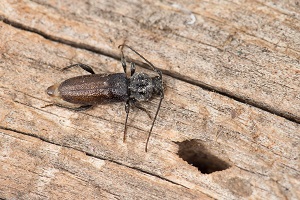The Department of Primary Industries and Regional Development (DPIRD) is reminding people this winter to clean up any dead or dry pinewood on their properties to help prevent the spread of European house borer (EHB).
The reminder comes after EHB was detected in the Shires of Waroona, Harvey, and Dardanup in past six months, south of previously known infestations in the greater Perth area.

DPIRD technical area coordinator Jenny Crisp said DPIRD had an ongoing program to manage and contain European house borer in Western Australia.
“EHB is mainly found in dead pine trees, dead parts of living trees and pine logs and other debris,” she said.
“If it is left uncontrolled, it can potentially cause structural damage to homes and restrict the interstate trade of pine products or items on pine pallets.
“Movement restrictions apply to known infested sites. We also recommend not moving unwanted seasoned pinewood between properties to help prevent spread from unknown sources.
“With the onset of cooler weather, now is a great opportunity to clean up and burn unwanted pinewood to protect your home from this serious wood pest.
“Before burning, the first step is to check the relevant local government website for specific burn related guidelines and permit requirements or speak to their Fire Officer.”
Additional information on how to conduct a planned burn is available on the Department of Fire and Emergency Services website, including registering a planned burn prior to lighting.
Ms Crisp said signs of EHB included small oval-shaped holes, which are three to five millimetres, running with the grain of the wood.
“The adult beetles are brownish-black, eight to 25mm long, with antennae half as long as their body and can be found resting on surfaces, such as a wall,” she said.
“The larvae are a creamy colour, with a rippled body and enlarged head, which can be found inside pinewood tunnels or galleries.”
Any suspected detections of European house borer should be reported to DPIRD via the MyPestGuide® Reporter app or to its Pest and Disease Information Service on +61 (0)8 9368 3080, email padis@dpird.wa.gov.au
For more information on European house borer visit www.agric.wa.gov.au/ehb


